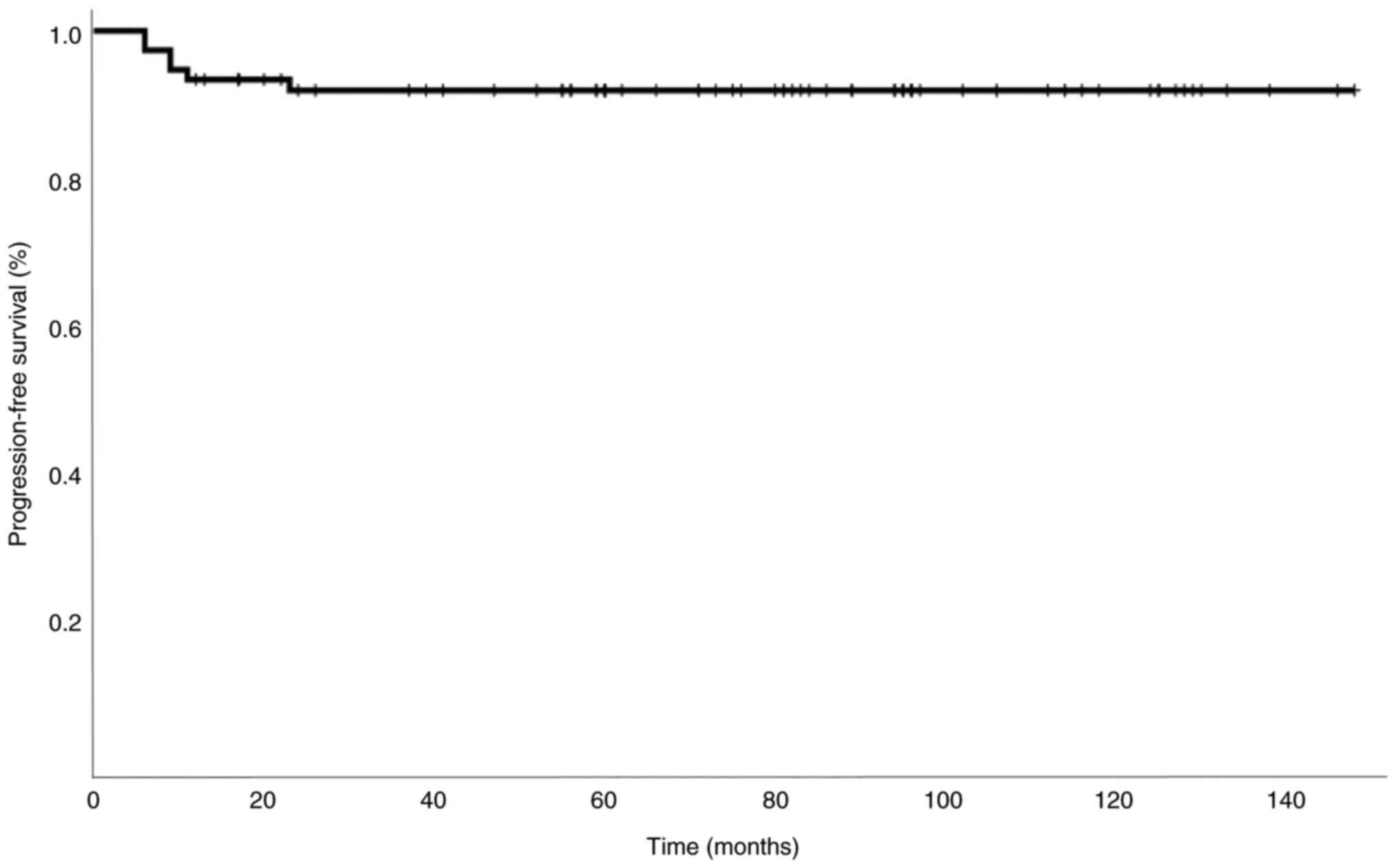|
1
|
Melmed S: Pathogenesis of pituitary
tumors. Nat Rev Endocrinol. 7:257–266. 2011.PubMed/NCBI View Article : Google Scholar
|
|
2
|
Lim CT and Korbonits MK: Update on the
clinicopathology of pituitary adenomas. Endocr Pract. 24:473–488.
2018.PubMed/NCBI View Article : Google Scholar
|
|
3
|
Brue T and Castinetti F: The risks of
overlooking the diagnosis of secreting pituitary adenomas. Orphanet
J Rare Dis. 11(135)2016.PubMed/NCBI View Article : Google Scholar
|
|
4
|
Russ S, Anastasopoulou C and Shafiq I:
Pituitary adenoma. In: StatPearls [Internet]. StatPearls
Publishing, Treasure Island, FL, 2021.
|
|
5
|
Chin SO: Epidemiology of functioning
pituitary adenomas. Endocrinol Metab (Seoul). 35:237–242.
2020.PubMed/NCBI View Article : Google Scholar
|
|
6
|
Hemminki K, Försti A and Ji J: Incidence
and familial risks in pituitary adenoma and associated tumors.
Endocr Relat Cancer. 14:103–109. 2007.PubMed/NCBI View Article : Google Scholar
|
|
7
|
Russ S, Anastasopoulou C and Shafiq I:
Pituitary adenoma. In: StatPearls [Internet]. StatPearls
Publishing, Treasure Island, FL, 2022.
|
|
8
|
Molitch ME: Diagnosis and treatment of
pituitary adenomas: A review. JAMA. 317:516–524. 2017.PubMed/NCBI View Article : Google Scholar
|
|
9
|
Ding D, Starke RM and Sheehan JP:
Treatment paradigms for pituitary adenomas: Defining the roles of
radiosurgery and radiation therapy. J Neurooncol. 117:445–457.
2014.PubMed/NCBI View Article : Google Scholar
|
|
10
|
Freda PU and Wardlaw SL: Clinical review
110: Diagnosis and treatment of pituitary tumors. J Clin Endocrinol
Metab. 84:3859–3866. 1999.PubMed/NCBI View Article : Google Scholar
|
|
11
|
Ciric I, Mikhael M, Stafford T, Lawson L
and Garces R: Transsphenoidal microsurgery of pituitary
macroadenomas with long-term follow-up results. J Neurosurg.
59:395–401. 1983.PubMed/NCBI View Article : Google Scholar
|
|
12
|
Serioli S, Doglietto F, Fiorindi A, Biroli
A, Mattavelli D, Buffoli B, Ferrari M, Cornali C, Rodella L,
Maroldi R, et al: Pituitary adenomas and invasiveness from
anatomo-surgical, radiological, and histological perspectives: A
systematic literature review. Cancers (Basel).
11(1936)2019.PubMed/NCBI View Article : Google Scholar
|
|
13
|
Chanson P, Dormoy A and Dekkers OM: Use of
radiotherapy after pituitary surgery for non-functioning pituitary
adenomas. Eur J Endocrinol. 181:D1–D3. 2019.PubMed/NCBI View Article : Google Scholar
|
|
14
|
Scheick S, Amdur RJ, Kirwan JM, Morris CG,
Mendenhall WM, Roper S and Friedman W: Long-term outcome after
fractionated radiotherapy for pituitary adenoma: The curse of the
secretory tumor. Am J Clin Oncol. 39:49–54. 2016.PubMed/NCBI View Article : Google Scholar
|
|
15
|
Sebastian P, Balakrishnan R, Yadav B and
John S: Outcome of radiotherapy for pituitary adenomas. Rep Pract
Oncol Radiother. 21:466–472. 2016.PubMed/NCBI View Article : Google Scholar
|
|
16
|
Rim CH, Yang DS, Park YJ, Yoon WS, Lee JA
and Kim CY: Radiotherapy for pituitary adenomas: Long-term outcome
and complications. Radiat Oncol J. 29:156–163. 2011.PubMed/NCBI View Article : Google Scholar
|
|
17
|
Rutkowski M and Zada G: Management of
pituitary adenomas invading the cavernous sinus. Neurosurg Clin N
Am. 30:445–455. 2019.PubMed/NCBI View Article : Google Scholar
|
|
18
|
Loeffler J and Shih HA: Radiation therapy
in the management of pituitary adenomas. J Clin Endocrinol Metab.
96:1992–2003. 2011.PubMed/NCBI View Article : Google Scholar
|
|
19
|
Langsenlehner T, Stiegler C, Quehenberger
F, Feigl GC, Jakse G, Mokry M, Langsenlehner U, Kapp KS and Mayer
R: Long-term follow-up of patients with pituitary macroadenomas
after postoperative radiation therapy: Analysis of tumor control
and functional outcome. Strahlenther Onkol. 183:241–247.
2007.PubMed/NCBI View Article : Google Scholar
|
|
20
|
Colin P, Jovenin N, Delemer B, Caron J,
Grulet H, Hecart AC, Lukas C, Bazin A, Bernard MH, Scherpereel B,
et al: Treatment of pituitary adenomas by fractionated stereotactic
radiotherapy: A prospective study of 110 patients. Int J Radiat
Oncol Biol Phys. 62:333–341. 2005.PubMed/NCBI View Article : Google Scholar
|
|
21
|
Sasaki R, Murakami M, Okamoto Y, Kono K,
Yoden E, Nakajima T, Nabeshima S and Kuroda Y: The efficacy of
conventional radiation therapy in the management of pituitary
adenoma. Int J Radiat Oncol Biol Phys. 47:1337–1345.
2000.PubMed/NCBI View Article : Google Scholar
|
|
22
|
Becker G, Kocher M, Kortmann RD, Paulsen
F, Jeremic B, Müller RP and Bamberg M: Radiation therapy in the
multimodal treatment approach of pituitary adenoma. Strahlenther
Onkol. 178:173–186. 2002.PubMed/NCBI View Article : Google Scholar
|
|
23
|
Kokubo M, Sasai K, Shibamoto Y, Aoki T,
Oya N, Mitsumori M, Takahashi JA, Hashimoto N and Hiraoka M:
Long-term results of radiation therapy for pituitary adenoma. J
Neurooncol. 47:79–84. 2000.PubMed/NCBI View Article : Google Scholar
|
|
24
|
Minniti G, Jaffrain-Rea ML, Osti M,
Esposito V, Santoro A, Solda F, Gargiulo P, Tamburrano G and Enrici
RM: The long-term efficacy of conventional radiotherapy in patients
with GH-secreting pituitary adenomas. Clin Endocrinol (Oxf).
62:210–216. 2005.PubMed/NCBI View Article : Google Scholar
|
|
25
|
Jallad RS, Musolino NR, Salgado LR and
Bronstein MD: Treatment of acromegaly: Is there still a place for
radiotherapy? Pituitary. 10:53–59. 2007.PubMed/NCBI View Article : Google Scholar
|
|
26
|
Wilson PJ, De-Loyde KJ, Williams JR and
Smee RI: A single centre's experience of stereotactic radiosurgery
and radiotherapy for non-functioning pituitary adenomas with the
linear accelerator (Linac). J Clin Neurosci. 19:370–374.
2012.PubMed/NCBI View Article : Google Scholar
|
|
27
|
Gheorghiu ML and Fleseriu M: Stereotactic
radiation therapy in pituitary adenomas, is it better than
conventional radiation therapy? Acta Endocrinol (Buchar).
13:476–490. 2017.PubMed/NCBI View Article : Google Scholar
|















